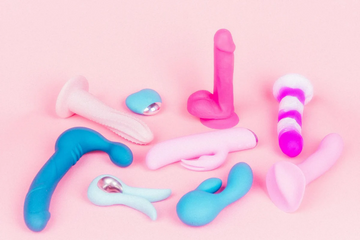How to Make a Dildo: A Complete Guide
The market today is filled with various types of dildos, offering an extensive range of options. However, there is very little information on how to make a dildo yourself! If you're a DIY enthusiast or simply curious about the production process, this blog will take you through the detailed steps of dildo making, including material selection, mold creation, casting, and safety testing.

Why Make a Dildo Yourself?
There are several reasons why people choose to make their own dildos:
- Customization: You can create a dildo that perfectly suits your size, shape, and color preferences.
- Cost Savings: Making your own dildo can be more budget-friendly than buying a premium one.
- Creative & Fun: The process is engaging and can be a fun DIY project.
- Temporary Alternatives: If you don’t have access to a store-bought dildo, DIY methods can provide a makeshift solution.

Common Household Objects Resembling Dildos
If you need an alternative right away, your kitchen might be the best place to look. Many vegetables and household items can temporarily function as dildos, but they come with safety concerns.
🍌 Banana
✅ Pros:
- Naturally shaped, soft, and flexible.
- Readily available and inexpensive.
❌ Cons:
- Too soft and lacks firmness.
- The skin can tear easily, leaving residue inside, which poses an infection risk.
🥒 Cucumber, Eggplant, Carrot
✅ Pros:
- Firm texture and various sizes to suit different needs.
- Smooth surface, relatively safe.
❌ Cons:
- Must be thoroughly cleaned and used with a condom to avoid bacteria.
- May contain pesticide residue that is harmful to health.
🌽 Corn
✅ Pros:
- Its textured surface can provide additional stimulation.
- Rigid structure prevents bending.
❌ Cons:
- The rough texture may cause discomfort or irritation.
- Must be treated for safety before use.
⚠️ Important: Never use vegetables or fruits directly as dildos without a condom and proper lubrication. Even if thoroughly washed, they may still have pesticide residues and bacteria, which can lead to infections.
How to Make a Safe and Effective Dildo
If you're interested in creating a safe, hygienic, and durable dildo, follow these steps.
🛠️ Choosing the Right Materials
The most crucial part of making a dildo is selecting safe, non-toxic, and body-compatible materials. Here are some recommended options:
- Silicone: Medical-grade silicone is non-toxic, hypoallergenic, and highly flexible.
- Plaster: Used for making molds but should not come in direct contact with the skin.
- Epoxy Resin: Harder texture, but only safe if it's food-grade or medical-grade.
- Latex: Offers great elasticity, but some people are allergic to latex.
🎨 Step-by-Step Guide to Making a Dildo
Step 1: Creating the Mold
-
Select a mold base
- You can use a store-bought dildo as a reference mold or find a suitable cylindrical object.
- For a fully customized shape, consider 3D printing a model.
-
Make the mold using plaster or silicone
- Place the reference object in a container and pour liquid plaster or mold silicone over it.
- Let it solidify, then carefully remove the original object.
Step 2: Casting the Dildo
-
Prepare the Liquid Silicone
- Choose food-grade or medical-grade silicone.
- Mix the silicone with the curing agent as per instructions, ensuring it is well blended.
-
Pour into the Mold
- Slowly pour the mixture into the mold, minimizing air bubbles.
- Lightly tap the mold to help the silicone settle evenly.
-
Wait for Curing
- The curing process usually takes 24 hours, but check the specific material's instructions.
-
Demolding
- Gently open the mold and extract the newly formed dildo.
- Use fine tools to trim any rough edges for a smooth finish.
Step 3: Post-Processing
-
Cleaning and Sanitization
- Wash with warm water and mild soap.
- Disinfect with rubbing alcohol to ensure hygiene.
-
Coloring and Detailing
- Use body-safe dyes to add realistic tones if desired.
-
Testing Flexibility
- Squeeze the dildo to ensure it has both firmness and flexibility.
🛡️ Safety Testing
To ensure your DIY dildo is safe for use, conduct these tests: ✅ Heat Resistance Test: Check if the material withstands temperatures above 60°C (140°F) without melting or deforming.
✅ Elasticity Test: Ensure it has enough flexibility to prevent discomfort or injury.
✅ Surface Smoothness: There should be no sharp edges or rough textures that could cause harm.
⚠️ Caution: Never use toxic materials or untested chemicals, as they can pose health risks.
📌 DIY vs. Buying a Dildo
If you don’t want to go through the process of making a dildo, buying one might be a more safe and convenient option. The market offers a variety of sizes and functionalities:
- 6inch dildo (Beginner-Friendly): Great for first-time users.
- 9inch dildo (Intermediate Users): For those seeking more intense sensations.
- 12inch dildo (Advanced Players): For experienced users looking for maximum stimulation.
Additionally, vibrating dildos with 10 speed settings are available for extra pleasure, starting at $39.99. You can browse our official sextoysstore to find the most suitable product.

How I Made My Own DIY Dildo
If you're curious about how to create your own DIY dildo, I’ll share the step-by-step process I used to make one at home. It’s simple, cost-effective, and can be customized to your preferred size and texture.
📌 Step-by-Step Guide to Making Your Own Dildo
Step 1: Cutting the Sponge to the Desired Shape
- Trim the sponge using scissors to create the desired size and shape.
- For added texture: Layer or fold the sponge to increase thickness.
- If the sponge is too soft, stack multiple pieces together for a firmer texture.
Step 2: Wrapping and Securing the Structure
- Wrap the sponge in plastic wrap to hold it in place and maintain its shape.
- Ensure the edges are smooth and rounded to avoid discomfort.
Step 3: Insert Into a Condom for Hygiene
- Stretch a lubricated condom over the entire sponge structure.
- Make sure it is fully covered, with no rough edges exposed.
- For extra safety, consider using a double-layered condom.
✨ Customization Options
- Increase safety: Double-layer the condom for added durability.
- Customize color: Use a colored condom for an aesthetically pleasing look.
⚠️ Important Safety Tips
✅ Always use a new condom to maintain hygiene.
✅ Avoid sharp or rough materials that may cause irritation.
✅ Use water-based lubricant to reduce friction and enhance comfort.
✅ Discard after use – Do not reuse, as bacteria can accumulate.
Product Recommendations
You can make your own dildo, or simply invest in a safe and comfortable dildo that won't cost you too much
When I was very young, I was often embarrassed about my purchasing power and living with my parents. As a teenager, I often looked forward to a set of dildo toys. That is the purpose of this blog post from my own perspective:
How to make a dildo easily?
Of course, you can also use condoms + any products to easily get a DIY dildo, but
- Here are some combination dildos made with condoms + water + models
- Condoms + water + Coke bottle
- Condoms + gelatin + toilet paper rolls
These DIY dildos cannot avoid some shortcomings, reminding you that they are disposable items.
Free dildo This series contains all the products that are suitable for people who want to experience dildo. The product is 0 US dollars, you only need to pay the postage, or you can buy it with other products to meet the free shipping!
Final Thoughts
Making your own dildo can be a fun, creative, and educational experience, helping you understand the materials and design aspects of sex toys. However, if safety and comfort are your priorities, purchasing a professionally manufactured product is always a good idea.
Whichever path you choose, always prioritize hygiene, safety, and body compatibility for the best experience.
Have you ever tried making your own dildo? Share your experience in the comments! 😉





